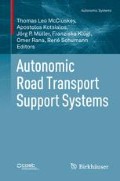Abstract
Inspired by diverse organic systems, autonomic computing is a rapidly growing field in computing science. To highlight this advancement, this chapter summarises the autonomic features utilised in a traffic signal control in the form of an operational control system, not simply a simulation study. In addition, the real-time simulation is used to refine the raw sensor data into a comprehensive picture of the traffic situation. We apply the multi-agent approach both for controlling the signals and for modelling the prevailing traffic situation. In contrast to most traffic signal control studies, the basic agent is one signal (head) also referred to as a signal group. The multi-agent process occurs between individual signal agents, which have autonomy to negotiate their timing, phasing, and priorities, limited only by the traffic safety requirements. The key contribution of this chapter lies not in a single method but rather in a combination of methods with autonomic properties. This unique combination involves a real-time microsimulation together with a signal group control and fuzzy logic supported by self-calibration and self-optimisation. The findings here are based on multiple research projects conducted at the Helsinki University of Technology (now Aalto University). Furthermore, we outline the basic concepts, methods, and some of the results. For detailed results and setup of experiments, we refer to the previous publications of the authors.
Access this chapter
Tax calculation will be finalised at checkout
Purchases are for personal use only
References
Robertson, D.I., Bretherton, R.D.: Optimizing networks of traffic signals in real time: the scoot method. IEEE Trans. Veh. Technol. 40(1), 11–15 (1991)
Sims, A.G., Dobinson, K.W.: The Sydney coordinated adaptive traffic (scat) system philosophy and benefits. IEEE Trans. Veh. Technol. 29(2), 130–137 (1980)
Vincent, R.A., Peirce, J.R., Webb, P.J.: Mova traffic control manual (1990)
Maoro, V., Taranto, C.D.: Utopia. In: Proceedings of 6th IFAC/IFIP/IFORS Symposium on Control, Computers and Communications in Transportation. IFAC, Paris (1989)
Gokulan, B.P., Srinivasan, D.: Distributed geometric fuzzy multiagent urban traffic signal control. IEEE Intell. Transp. Syst. 11(3), 714–727 (2010)
Dusparic, I., Cahill, V.: Using distributed w-learning for multi-policy optimization in decentralized autonomic systems. In: Proceedings of the 6th International Conference on Autonomic Computing, pp. 63–64. ACM, New York (2009)
Shirai, T., Konaka, Y., Yano, J., Nishimura, S., Kagawa, K., Morita, T., Numao, M., Kurihara, S.: Multi-agent traffic light control framework based on direct and indirect coordination. In: Proceedings of 7th International Workshop on Agents in Traffic and Transportation, pp. 9–17 (2012)
de Oliveira, L.B., Camponogara, E.: Multi-agent model predictive control of signaling split in urban traffic networks. Transp. Res. C Emerg. Technol. 18(1), 120–139 (2010)
Kronborg, P., Davidsson, F., Edholm, J.: Sos - self optimising signal control, development and field trials of the sos algorithm for self optimising signal control at isolated intersections. Technical report, TFK, Sweden (1997)
Wong, S.C., Wong, W.T., Leung, C.M., Tong, C.O.: Group-based optimization of a time-dependent transyt traffic model for area traffic control. Transp. Res. B Methodol. 36(4), 291–312 (2002)
Niittymäki, J., et al.: Fuzzy traffic signal control: principles and applications. Ph.D. thesis, Helsinki University of Technology (2002)
Niittymäki, J.: Using fuzzy logic to control traffic signals at multi-phase intersections. In: Computational Intelligence, pp. 354–362. Springer, Heidelberg (1999)
Kosonen, I.: HUTSIM-Urban traffic simulation and control model: principles and applications. Ph.D. thesis, Helsinki University of Technology (1999)
Chen, B., Cheng, H.H.: A review of the applications of agent technology in traffic and transportation systems. IEEE Trans. ITS 11(2), 485–497 (2010)
Al-Mudhaffar, A., Archer, J., Cunningham, A.: Resolving the driver’s dilemma: improving vehicle actuated signal control for safety and performance. In: World Conference on Transport Research (2004)
Čapek, K., Kosonen, I., Luttinen, R.T.: Sink&source – an approach for real-time corrections of an online microscopic traffic simulation. In: 13th World Congress and Exhibition on Intelligent Transport Systems (ITS) and Services, p. 8, London (2006)
Zadeh, L.A.: Fuzzy sets. Inf. Control 8(3), 338–353 (1965)
Kosonen, I.: Multi-agent fuzzy signal control based on real-time simulation. Transp. Res. C Emerg. Technol. 11(5), 389–403 (2003)
Pappis, C.P., Mamdani, E.H.: A fuzzy logic controller for a traffic junction. IEEE Trans. Syst. Man Cybern. 7(10), 707–717 (1977)
Pursula, M., Niittymaki, J.: Evaluation of traffic signal control with simulation – a comparison of the pappis-mamdani fuzzy control vs. vehicle-actuation with the extension principle. In: EURO-Conference, Newcastle (1996)
Bingham, E.: Reinforcement learning in neurofuzzy traffic signal control. Eur. J. Oper. Res. 131(2), 232–241 (2001)
Ma, X., Jin, J., Lei, W.: Multi-criteria analysis of optimal signal plans using microscopic traffic models. Transp. Res. D Transp. Environ. 32, 1–14 (2014)
Author information
Authors and Affiliations
Corresponding author
Editor information
Editors and Affiliations
Rights and permissions
Copyright information
© 2016 Springer International Publishing Switzerland
About this chapter
Cite this chapter
Kosonen, I., Ma, X. (2016). Traffic Signal Control with Autonomic Features. In: McCluskey, T., Kotsialos, A., Müller, J., Klügl, F., Rana, O., Schumann, R. (eds) Autonomic Road Transport Support Systems. Autonomic Systems. Birkhäuser, Cham. https://doi.org/10.1007/978-3-319-25808-9_15
Download citation
DOI: https://doi.org/10.1007/978-3-319-25808-9_15
Published:
Publisher Name: Birkhäuser, Cham
Print ISBN: 978-3-319-25806-5
Online ISBN: 978-3-319-25808-9
eBook Packages: Computer ScienceComputer Science (R0)

